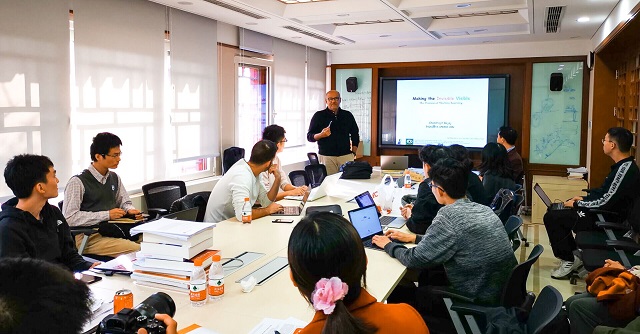Professor Chandrajit Bajaj from University of Texas at Austin Visits CFCS
On November 12th, 2018, Professor Chandrajit Bajaj from University of Texas at Austin visited the Center on Frontiers of Computing Studies of PKU and gave a lecture titled "Making the Invisible, Visible". Professor Baoquan Chen from CFCS hosted the lecture.

Abstract:
RGB multispectral video that span the visible electromagnetic spectrum (400 nm - 700 nm) are now commonplace, with the advent of color video cameras. Near, mid, far Infrared (IR) hyper spectral imaging, that capture a portion of the human invisible spectrum (700 nm - 1mm) have additionally proven indispensable for many scenarios such as night vision, video surveillance, terrain sensing via satellites. Both multispectral and hyper spectral forms of imagery are now seeing use for navigation/control, in automobiles, transport vehicles and even drones. This spectral imagery, enables the simultaneous prediction of the visible and invisible geometry and material properties of complex scenes. This talk shall dwell on the success, and current challenges of state of the art, machine learning algorithms for spectral de-noising, semantic segmentation, data fusion, super-resolution.
Biography:
Chandrajit Bajaj is the director of the Center for Computational Visualization, in the Institute for Computational and Engineering Sciences (ICES) and a Professor of Computer Sciences at the University of Texas at Austin. Bajaj holds the Computational Applied Mathematics Chair in Visualization. He is also an affiliate faculty member of Mathematics, Computational Neuroscience and Electrical Engineering. He is currently on the editorial boards for the International Journal of Computational Geometry and Applications, and the ACM Computing Surveys, and past editorial member of the SIAM Journal on Imaging Sciences. He was awarded a distinguished alumnus award from the Indian Institute of Technology, Delhi, (IIT, Delhi). He is also a Fellow of The American Association for the Advancement of Science (AAAS), Fellow of the Association for Computing Machinery (ACM), Fellow of the Institute of Electrical and Electronic Engineers (IEEE), and Fellow of the Society of Industrial and Applied Mathematics (SIAM).






